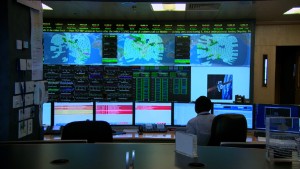
Malaysian Remote Sensing
Agency (MRSA) received new satellite images from France that were taken
on March 23. The images showed 122 potential objects in one area of the
ocean. Some of the objects were as much as 23 meters in length. Some
appeared bright, possibly indicating solid material. They were located
about 2,500 kilometers from Perth. "This is another new lead that will
help direct the search operation," said Acting Minister of
Transportation Hishammuddin Bin Hussein on Wednesday.
Cheng Li Ping is afraid to tell her sons their father might never come home.
"My heart can't handle
it. I don't want to hurt my children," the Chinese woman told CNN
Wednesday as she waited in Kuala Lumpur for evidence about what happened
to her husband and the 238 others who were aboard Malaysia Airlines
Flight 370.
Cheng says she cannot
bring herself to accept that her husband is dead, even after authorities
announced there were no survivors.
"I can't trust the
Malaysian government. I can't work now because all I can think about is
my husband and my children," she told CNN's Sara Sidner in Kuala Lumpur.
"I don't have strength. ... My head is a mess."
 Photos: The search for Malaysia Airlines Flight 370
Photos: The search for Malaysia Airlines Flight 370
 Wife grieves for husband missing on MH370
Wife grieves for husband missing on MH370
 Ships forced to leave search zone
Ships forced to leave search zone
 'Eventually something will come to light'
'Eventually something will come to light'
Malaysian officials say
they can tell you how Flight 370 ended. It crashed into the Indian
Ocean, they'll say, citing complicated math as proof.
They can tell you when
it probably happened -- on March 8, sometime between 8:11 and 9:15 a.m.
(7:11 to 8:15 p.m. ET March 7), handing you a sheet with extraordinarily
technical details about satellite communications technology.
What they still can't tell you is why, or precisely where, or show you a piece of the wreckage.
The search
In a remote area of the
southern Indian Ocean, where experts calculate the plane is likely to
have ended up, search and recovery teams from six different countries
are hunting for pieces of debris.
The search resumed Wednesday after stormy weather put it on hold for the whole of Tuesday.
Seven military
reconnaissance planes -- from Australia, China, New Zealand, the United
States, Japan and South Korea -- and five civil aircraft are making
flights over the vast area over the course of the day.
And five ships, one from Australia and four from China, are in the search zone, Australian authorities said.
Satellites have detected
objects afloat in the ocean over the past week and a half. And
Australian and Chinese surveillance planes both reported seeing items of
debris on the surface this week, but so far nothing has been recovered
or definitively linked to the missing flight.
Officials have warned
that objects spotted in the water may turn out to be flotsam from cargo
ships, and that finding anything from the plane could still take a long
time.
"There's always a
possibility we might not actually find something next week or the week
after," Mark Binskin, vice chief of the Australian Defence Force, told
CNN's Kate Bolduan on Tuesday. "I think eventually something will come
to light, but it's going to take time."
The hardware
If search teams are able
to find debris confirmed to be from the plane, that would help
officials figure out roughly where the aircraft went down.
They would then be able
to focus the search under the water to try to locate larger pieces of
wreckage and the all-important flight data recorder, which may hold
vital clues about what happened on board the night the plane
disappeared.
 How Inmarsat found MH370's path
How Inmarsat found MH370's path
 Source: Flight 370 turned, dropped
Source: Flight 370 turned, dropped
 Flight 370 relative: This is a cover-up
Flight 370 relative: This is a cover-up
 Families told all lives are lost
Families told all lives are lost
 The deep sea robot search for 370
The deep sea robot search for 370
U.S. hardware designed
to help with that task arrived Wednesday in Perth, the western
Australian city that is serving as the base for the search efforts.
The United States sent a
Bluefin-21 autonomous underwater vehicle, which can search for
submerged objects at depths as low as 14,700 feet, and a TPL-25, a giant
listening device that can help pinpoint the location of pings from the
flight data recorder. Towed behind a ship, the TPL-25 can detect pings
at a maximum depth of 20,000 feet.
Time is against that
part of the search, though, as the plane's pinger is expected to run out
of power within the next two weeks. The Indian Ocean has an average
depth of about 13,000 feet.
The families
The wait for answers
about what happened to the plane and where it is now has taken a hard
toll on the family members of those on board.
Many relatives of Chinese passengers, like Cheng, refuse to accept the Malaysian government's version of events.
In Beijing, hundreds of them marched to the Malaysian Embassy on Tuesday to voice their anger and frustration.
And on Wednesday, they
accused Malaysia Airlines of falling short on its promises to provide
volunteer caregivers and accommodations for some family members. The
airline couldn't immediately be reached for comment.
The Chinese relatives were particularly upset by Malaysian authorities' announcement Monday that they had concluded that the plane had crashed into the southern Indian Ocean with the loss of all lives aboard.
Some family members said
they weren't satisfied by the Malaysian government's explanation, which
was based on an expert analysis of satellite data. They said it was
covering up the truth and demanded tangible evidence that the plane had ended up in the ocean.
The Chinese government,
whose citizens made up two thirds of the passengers on board the missing
plane, also said it wanted more information from the Malaysian side.
President Xi Jinping has sent a special envoy to Kuala Lumpur to deal
with the matter.
Malaysian officials
released more details on the satellite analysis Tuesday and said they
understood the families' need to see physical evidence from the plane to
get closure. They said they had made the announcement "out of a
commitment to openness and respect for the relatives."
The backlash
The Malaysians' comments
appeared to have done little to placate the anger among the families,
though, and it appeared to be spreading more widely among the Chinese
public.
Some Chinese celebrities used social media to urge people to boycott Malaysian products and visits to the country.
Chen Kun, one of China's
most popular actors, accused the Malaysian government and Malaysia
Airlines of "clownish prevarication and lies." His post Tuesday calling
for a boycott was reposted more than 65,000 times on Weibo, China's
Twitter-like microblogging platform.
"I've never been to
Malaysia, and I will no longer plan to go there anymore," Meng Fei, the
host of one of China's most popular TV shows, wrote Wednesday on Weibo,
calling for others to repost the comments if they felt the same. More
than 120,000 users did.
Other social media users, albeit with smaller followings, argued against punishing Malaysia as a whole over the matter.
Chen Shu, a journalist,
warned that a boycott would "hurt the relationship of Chinese and
Malaysians" and long-term regional ties.
Chinese authorities
regularly censor Weibo posts. The fact that the anti-Malaysian posts by
high-profile users weren't deleted suggested either tacit approval or at
least an unwillingness to wade into the debate by Chinese government
censors.
The legal action
In the United States, meanwhile, a Chicago-based attorney has taken the first formal legal steps related to the missing plane.
Monica Kelly, a lawyer
at Ribbeck Law, asked an Illinois state judge on Tuesday to order
Malaysia Airlines and Boeing, which manufactured the missing airplane,
to provide documents and other information.
Kelly is seeking
specific information about the airline's batteries, details on the fire
and oxygen systems and records related to the fuselage.
The filing appears to be
the first move toward U.S.-based litigation stemming from the March 8
incident. The firm said it plans to build a multi-million dollar suit
against the airline and Boeing.
Boeing declined to comment on the matter late Tuesday, and Malaysia Airlines officials weren't immediately available.
No comments:
Post a Comment